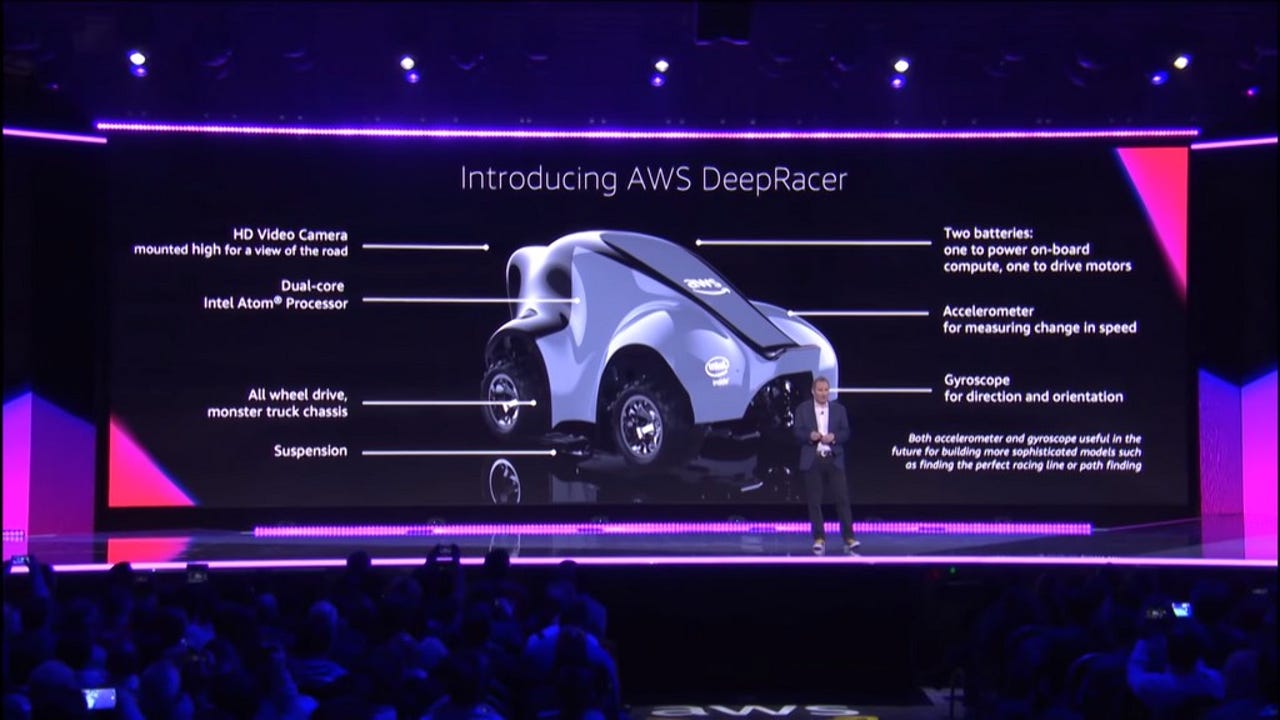DeepRacer: Will Amazon's own programmable toy car interest you in AI?


Featured
No single technology in human history has succeeded in becoming ubiquitous without first capturing the public's heart. For greater than a century, even when there were no working prototypes of a "thinking thing," the idea of a mechanical intelligence has grabbed a variable degree of hold on the public's imagination.
Fifty years ago, Douglas C. Engelbart produced the first live demonstration of a working computer whose database was operated by a mouse pointer. It did not excite the imagination or capture the heart for one reason only: Very few in the general public were allowed to see the demo, or even know of its existence until surprisingly recently.
Also: AWS re:Invent 2018 Postmortem: Surprise! Hybrid enters the agenda
At its most recent re:Invent conference in November, Amazon AWS CEO Andy Jassy introduced attendees to DeepRacer, an Intel Atom-based autonomous processor mounted on the chassis of a 1/18-scale, formerly radio-controlled monster truck, with Wi-Fi connectivity to the AWS cloud. It's a revelation that anyone can see for herself, but for DeepRacer to capture the public's heart, it may first need to beg their indulgence.
"It's great to learn about things, but what are some things that we can provide to give people hands-on experience?" said Jassy. "Because the best way of learning is to actually try it. . . What can we do that'll allow people to get real hands-on experience? We had a long brainstorm about this."
Neurons on wheels
DeepRacer is a consumer-grade device clearly intended to get consumers directly engaged in the machine learning process -- to make them into participants in, not just witnesses to, artificial intelligence.
Also: Amazon re:Invent Preview: RockSet and Yotascale take their bows
The Amazon business model has always been to supply individuals with a physical device with which to consume its services. This was the case with Kindle, later with Fire, then with Echo, last year with DeepLens, and most recently -- albeit on a limited, experimental scale -- with DeepRacer. It's a 1/18-scale autonomous car that Amazon is making available for pre-order exclusively for $249, whose direction comes from a wireless connection with AWS' cloud services. Warehouses are due to begin shipping on March 19.
DeepRacer can be trained on a virtual racecourse, where a simulated form of the car may be trained using reinforcement learning techniques, guided by AWS' existing platform for AI, called SageMaker. In this virtual environment, the simulated intelligence may safely make mistakes about how to guide itself around a racecourse. Once effectively trained (apparently at the car owner's discretion), the program may be transferred to the physical car, where it may apply its lessons on a course that matches the specifications of the virtual course on which it was trained -- a simple, slightly bent, oval course for now.
Also: Amazon re:Invent: Data partner news summary
Can the cloud be the 'brain?'
What DeepRacer is not, technically speaking, is an artificially intelligent car. To be accurate about this, the "intelligence" that drives the car resides on AWS' cloud. There, the DeepRacer system learns about the car's environment, and sends operating instructions over wireless link to the car. That does make the device an autonomous car, though in one respect, not an AI car.
If you're asking yourself, "What's the difference?" then you may be asking the question of the year. DeepRacer brings to the forefront the issue of whether the decision-making element for a future autonomous vehicle actually belongs in the vehicle itself. Put another way, wouldn't the theoretical capability of cloud-based processors, coupled with the other, equally theoretical capability of 5G connectivity, be faster than a dual-core CPU with flash memory and an SSD drive? Maybe Amazon is onto something.
Also: Top cloud providers 2018: How AWS, Microsoft, Google, IBM, Oracle, Alibaba stack up
"After much brainstorming, we decided against building a scale-model data center, and using [SageMaker] RL to manage the cooling," stated Mike Miller, AWS' senior manager for AI devices, during a re:Invent session last month -- without any hint of authenticity that particular moment. "But to be honest, that would've been pretty cool."
The consumer model
Rather than a micro-data center on wheels, DeepRacer is actually a vehicle of a very different kind: A consumer-grade delivery vehicle for Amazon and Intel services.
Neural networks are very heavy consumers of data. Yes, storage is cheap nowadays, but mounting a multi-terabyte RAID array to your toy car might not be a practical option. The DeepRacer car has only 32GB of internal storage and 4GB of RAM, which are not nearly enough to manage the colossal scale of a convolutional neural network (yes, this is a CNN) examining the data contents of real-time video.
Training DeepRacer is a process that requires one to have at least an interest in, if not personal skills with, software development. That's where Amazon gets its chance to enlist you into the ranks of heavy consumers of AWS data and services.
Also: AWS' new buzzword: Builder
There are several such services attached to DeepRacer with which, if you get involved with it to any serious extent, you'll find yourself becoming more and more familiar:
- Amazon SageMaker RL: AWS' modeling system, specifically geared for reinforcement learning. A model being trained using RL has no initial idea of what is "right" or "wrong" about anything it tries, but it learns by way of a points scheme that rewards good behaviors. Most AI decision trees through history have involved some type of value scheme. For RL, the rules for such a scheme are discovered along the way through trial-and-error, as opposed to a more classical scheme like a chess move algorithm where the rules are known in advance and the potential values of future moves are calculated ahead of time. This makes RL more conducive to a race course, where the rules may seem simple enough (e.g., "Stay between the white lines") but the methodologies for following those rules may differ. Those differences may hint at the inkling of a legitimate strategy, at least theoretically, if the RL model evolves to that extent.
- AWS RoboMaker: A simulation environment engineered for robotics applications, which may be applied to any kind of autonomous device that's programmed in a similar fashion. Also formally unveiled during the last re:Invent conference, it's a virtual staging environment for Robot Operating System (ROS), an existing open source project whose goal is to forge a common platform for robotics engineers to model behavior. RoboMaker also features a 3D graphical environment so the developer can envision the situation, or the "world," in which the unit functions. For DeepRacer's purposes, SageMaker RL (the "reasoning system," if you will) renders operating instructions in a form that RoboMaker can digest (the "motor functions" system) and put into action. The RoboMaker environment is pre-programmed with physics that enable it to render a true-to-life facsimile of DeepRacer on a virtual racecourse, along with the physics of the course that may play a role in the physical car's performance (for instance, whether the course is concrete or wool carpet).
- Berkeley Caffe, Apache MXNet, and/or TensorFlow: These are open source machine learning frameworks, with which a developer produces the model for what is being learned within the system. Each framework includes a high-performance computational engine, necessary for deducing the reward values for potential courses of action in real-time or near-real-time.
- Intel Open Visual Inference and Neural Network Optimization Toolkit (OpenVINO): Developed by Intel and announced last May, its purpose is to absorb the data already collected by open source neural network models, and leverage features intentionally built into Intel's processor microarchitecture to derive meaningful observations from that data. OpenVINO includes an open source rendition of one of the principal components of AI: an inference engine. In its simplest form, it's software designed to draw conclusions about the data it sees. The notion that such a program can produce a fact as output, rather than just ingest such facts as inputs, is the distinguishing characteristic of AI. Intel (very cleverly) has engineered OpenVINO in such a way that training models produced for any of the three frameworks listed above are optimized for faster execution on Intel processors -- including Xeon server processors, the company's own FPGA accelerators, and DeepRacer's own little Atom CPU.
- Amazon Kinesis: The service's real-time streaming data processing toolkit, suitable for multimedia. (If you're wondering why some services are branded "Amazon" and others "AWS," the distinction may soon be rendered moot.)
- Amazon CloudWatch: The service's native monitoring system, in this case leveraged for capturing logs.
- AWS Lambda: The cloud-based functions used in determining the reward value for DeepRacer staying on-track at any given moment, are rendered using the so-called serverless programming model.
- Amazon S3: Of course, the very extensive data storage requirements of a CNN are fulfilled by AWS' service for binary large objects (BLOBs).
If you remember growing up, watching an ad for a Mattel Hot Wheels racing set, perhaps your first experience with small print involved the words, "Some items sold separately." DeepRacer "comes complete with everything you see here," to borrow a phrase from an announcer for a different toy set. But this time, the catch is that you would be paying for each of these services as an AWS subscriber. And you'll recall that I mentioned that a CNN is a heavy data consumer.
Also: AWS Outposts brings AWS cloud hardware on-premises
Amazon hopes to keep the interest level revved up by way of a DeepRacer League, in which participants compete for the fastest qualifying (solo) lap times. Presently, there are plans for monthly competitions in the virtual space, as well as physical competitions during AWS conferences throughout the year.
Must read
- Everything you need to know about AWS re:Invent 2018 (CNET)
- Amazon Web Services: A cheat sheet (TechRepublic)
Computing had already been a fact of people's lives for a few decades, until the Altair 8800 -- the first build-it-yourself computer kit -- broke through to the first hobbyists who dared give it a try. Up to now, everyday folks' most intimate view of AI has come from movies depicting robot uprisings or sudden sentience -- movies to which attendees received directions from Siri or Alexa. DeepRacer seeks to be the first AI device that's teachable by regular folks, and yet still desirable. For all its caveats and its innumerable dependencies, I can't lie to you: I want one.